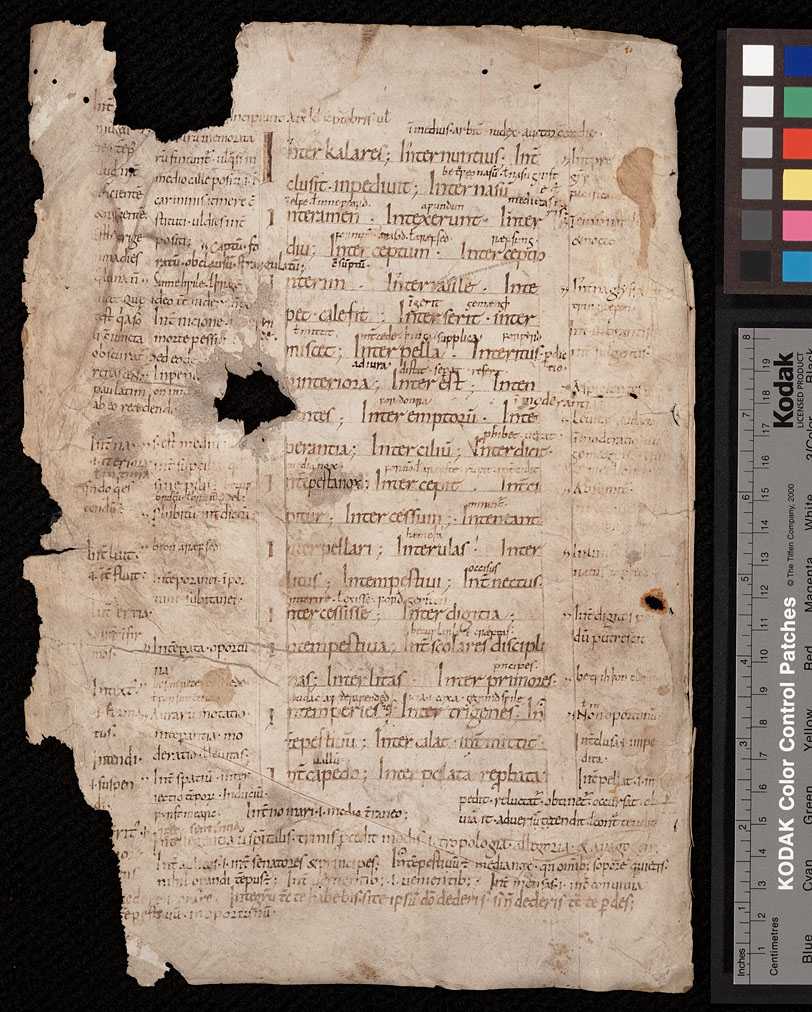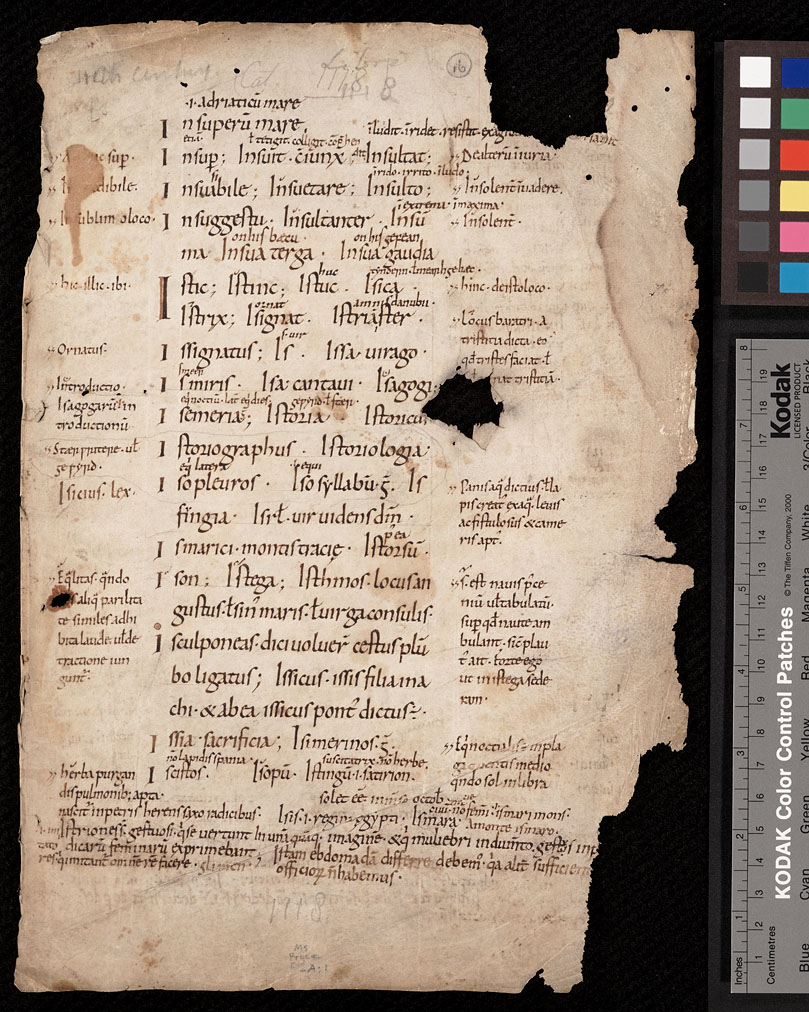Manuscript of the Month: A Previously Unknown Witness to a Medieval Dictionary and the Origins of Librarians
April 29th, 2020In memory of Richard Sharpe (1954-2020)
N. Kıvılcım Yavuz is conducting research on pre-1600 manuscripts at the Kenneth Spencer Research Library. Each month she will be writing about a manuscript she has worked with and the current KU Library catalog records will be updated in accordance with her findings.
MS 9/2:16 is one of dozens of fragmentary medieval manuscripts that are part of the holdings of the Kenneth Spencer Research Library. Originally part of a larger manuscript, this single parchment leaf was cut to size to be used as the cover of another book. Since the fragment was folded to fit this new host and the folds left quite an impression on the parchment, it can be estimated that the dimensions of the book our fragment was covering were about 156 x 96 x 43 mm. We do not, however, know what this book was.
![Image of a manuscript fragment (recto) possibly from Papias the Lombard’s Elementarium doctrinae rudimentum [Elementary Introduction to Learning]. France? Netherlands? 13th century? The fragment had been repurposed as the cover of a codex.](https://blogs.lib.ku.edu/spencer/wp-content/uploads/2020/04/01.-KSRL_MS-9-2-16_folio1r-1024x683.jpg)
![Image of a manuscript fragment (verso) possibly from Papias the Lombard’s Elementarium doctrinae rudimentum [Elementary Introduction to Learning]. France? Netherlands? 13th century? The fragment had been repurposed as the cover of a codex.](https://blogs.lib.ku.edu/spencer/wp-content/uploads/2020/04/02.-KSRL_MS-9-2-16_folio1v-1024x683.jpg)
As it stands, 27 lines of text in three columns on both sides of the leaf remain. The three-column layout with ample margins on either side suggests that this fragment was part of a manuscript of substantial size. The widest part of the width of the fragment measures approximately 290 mm. We can therefore estimate that the original manuscript leaf perhaps measured something like 450 x 300 mm. That is to say, this parchment leaf is now perhaps half the size it used to be. A reading of the text immediately reveals that this is some kind of glossary, dictionary or encyclopedia, as it contains an alphabetical list of terms with explanations. The part we have includes terms that begin with the letter L, and that is why there are repeated decorated initial Ls on both sides of the leaf, two of which are pen flourished in red and the other two in plain blue. We can see that not all the terms begin with a decorated initial but only the ones that have relatively lengthier explanations.
Ordinarily, a glossary would be at the end of a book or accompany a text and include terms particular to that work. It is, however, difficult to see what the terms in this fragment might have in common as they vary not only in the length of their descriptions but also in their subject matters. For example, the words included on the recto page range from “liber” (book) to “liberalis” (of or belonging to freedom), “libia” (Libya, a country in North Africa) and “libidinosus” (passionate).
As it is seen in the images of the manuscript above, the fragment has sustained significant water damage which caused some of the ink to bleed and smear on the page, especially on the recto side. In order to uncover the text on the parchment that was lost due to the water damage, I applied some digital manipulation techniques to the images before I began transcribing the text. Different contemporary image processing techniques can be applied to images of manuscripts to recover ink that is not visible to the naked eye. And, sometimes even only recalibrating the sharpness and the contrast of images will yield results, depending on the extent of the damage and the erasure. The images of this particular fragment required a little bit of more work than that but the results were really promising.
![Image of a manuscript fragment possibly from Papias the Lombard’s Elementarium doctrinae rudimentum [Elementary Introduction to Learning]. France? Netherlands? 13th century?, digitally processed to enhance the legibility of water-damaged text.](https://blogs.lib.ku.edu/spencer/wp-content/uploads/2020/04/03.-KSRL_MS-9-2-16_folio1r_manipulated-1024x683.jpg)
As I was transcribing, at first I thought this was a copy of part of the Etymologiae [Etymologies] by Isidore of Seville (c. 560–636). Also known as the Origines, Isidore’s work is an etymological encyclopedia. Due to its comprehensiveness and the overall encyclopedic mindset of medieval scribes, authors and compilers, the Etymologiae was one of the most copied and consulted books throughout the Middle Ages. The entirety of the Etymologiae consists of twenty books but it is common to see selected books, chapters or even individual passages copied in medieval manuscripts. If you have read my last blogpost on MS C189, you may remember that I mentioned that another work by Isidore of Seville, the Sententiae (Sentences), also was fairly popular during the Middle Ages, and selected parts of this work were found in manuscripts as part of larger compilations.
When I compared the text of MS 9/2:16 with Isidore’s Etymologiae, I noticed that the fragment did not follow the order of books and chapters of the work, although individual passages certainly were directly taken from the Etymologiae. For example, on the recto side of the fragment, the text moves from the fourteenth chapter to the twelfth chapter of the sixth book of the Etymologiae in the first column with no apparent break and then on to the fifth chapter of the ninth book in the second column before going to the fifth chapter of the fourteenth book in the third.
These kinds of textual rearrangements are no surprise when it comes to medieval manuscripts. Many texts were not simply copied but reorganized and rewritten in the Middle Ages to better suit the particular needs of individual scribes or authors at given times. Moreover, in MS 9/2:16, I found out that there were sentences, albeit only a handful, that did not originate from Isidore’s Etymologiae. This phenomenon of additions to existing texts is also not uncommon in medieval manuscripts and could have been done by the scribe of this manuscript. Yet, in this case, I think the scribe of MS 9/2:16 was just following an existing exemplar and not necessarily making new additions. I now believe Spencer’s fragment is not directly from Isidore’s Etymologiae, but from a copy of Papias the Lombard’s Elementarium doctrinae rudimentum [Elementary Introduction to Learning].
Described by Richard Sharpe as the “first fully recognizable dictionary,” the Elementarium was composed sometime before 1053, probably over several years in the 1040s. One of the sources for Papias’s Elementarium was the Etymologiae, and that is why we find passages that go back directly to the Isidore’s seventh-century encyclopedia in this fragment. A notable feature of Papias’s Elementarium is that it is organized in alphabetical order based on the first three letters of each word. We can easily confirm this by looking at MS 9/2:16, in which each entry starts not only with the letter L but also with the letters LIB before moving on to LIC and then to LID. Among other features of the work, this alphabetical organization in itself has been considered very innovative for its time.
It is very serendipitous that MS 9/2:16 as we have it begins in the middle of a chapter entitled “De librariis et eorum instrumentis” in Isidore’s Etymologiae (VI.xiv). We would be justified in reading the title of this chapter as “on librarians and their instruments” since the adjective “librarius” (“librariis” in dative) means a person concerned with or employed about books when it is used as a noun, and that is what librarians do! In the Middle Ages, though, “librarius” usually referred to a copyist, scribe, secretary or bookseller. Yet, the Latin word “librarius” is indeed the origin of the word “librarian” in English and all the way into the eighteenth century the word “librarian” still (also) carried all these meanings in English.
According to A Census of Medieval Latin Grammatical Manuscripts by G. L. Bursill-Hall, over a hundred manuscripts of Papias’s Elementarium survive. There are also at least four print editions dated before the fifteenth century, the first of which was published in Milan in 1476. (Three of these incunabula dated to 1485, 1491 and 1496 respectively are digitized by the Bayerische Staatsbibliothek, Germany.) Perhaps the high number of the witnesses in addition to the complexity of the work are the reasons why a full edition of the Elementarium has not been undertaken in modern times. Since there is no modern edition of the text with which our fragment can be compared, I soon will make available an annotated transcription of MS 9/2:16.
For an introduction to medieval dictionaries, read Richard Sharpe, “Vocabulary, Word Formation, Lexicography.” In Medieval Latin: An Introduction and Bibliographical Guide. Ed. by F. A. C. Mantello and A. G. Rigg (Washington, DC: Catholic University of America Press, 1996). 93–105.
N. Kıvılcım Yavuz
Ann Hyde Postdoctoral Researcher




